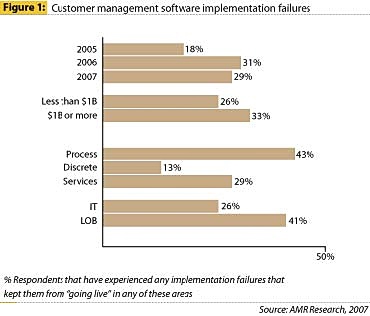New research into CRM implementation failures

AMR Research has released results of a new study describing CRM implementations. As the chart below shows, nearly one-third of CRM implementations fail:

The research suggests that CRM initiatives often fail due to insufficient end-user involvement and buy-in. Unlike ERP deployments, which tend to be back-end focused, successfully deploying end-user systems requires substantial user engagement:
This type of situation seems to be much more common in CRM, where user adoption, particularly by the sales organization, is one of the keys to success. In applications such as ERP, supply chain, or financial management applications, the users have much less flexibility or choice in whether or not to adopt an enterprise application standard.
Keep in mind that experience and success implementing ERP bears virtually no weight at all when implementing CRM. Also remember that, unlike an ERP implementation, the active involvement, support, and buy-in of the end users are critical to success. This posture is especially important given the relatively high and seemingly unchanging level of failed CRM implementations. Usability, integration to office productivity tools, and dashboards and reporting take top priority rather than sophisticated functionality, transaction speeds, and five nines of availability.
In my experience, many organizations equate "software implementation" with "back-end IT infrastructure." Unfortunately, this attitude increases the separation between IT and functional business units, where end-users live and work, worsening an already-significant problem.
Here is my four-item framework for evaluating whether end-users are sufficiently engaged in your implementation:
- Goal involvement. Have you developed a statement of business goals for the project that has been formally endorsed by the stakeholders, or was installing software the only formal goal?
- Project origin. Did an end-user group actively participate in defining project requirements and selecting the vendor, or was the project completely IT-driven?
- End-user benefit. Will the application give end-users valuable new capabilities, or is there little apparent benefit to end-users and managers?
- Project communications. Will stakeholders receive frequent updates on project status, or is that considered to be low priority?
The research is clear: engage end-users for a more successful implementation. Ignore end-users at your peril.